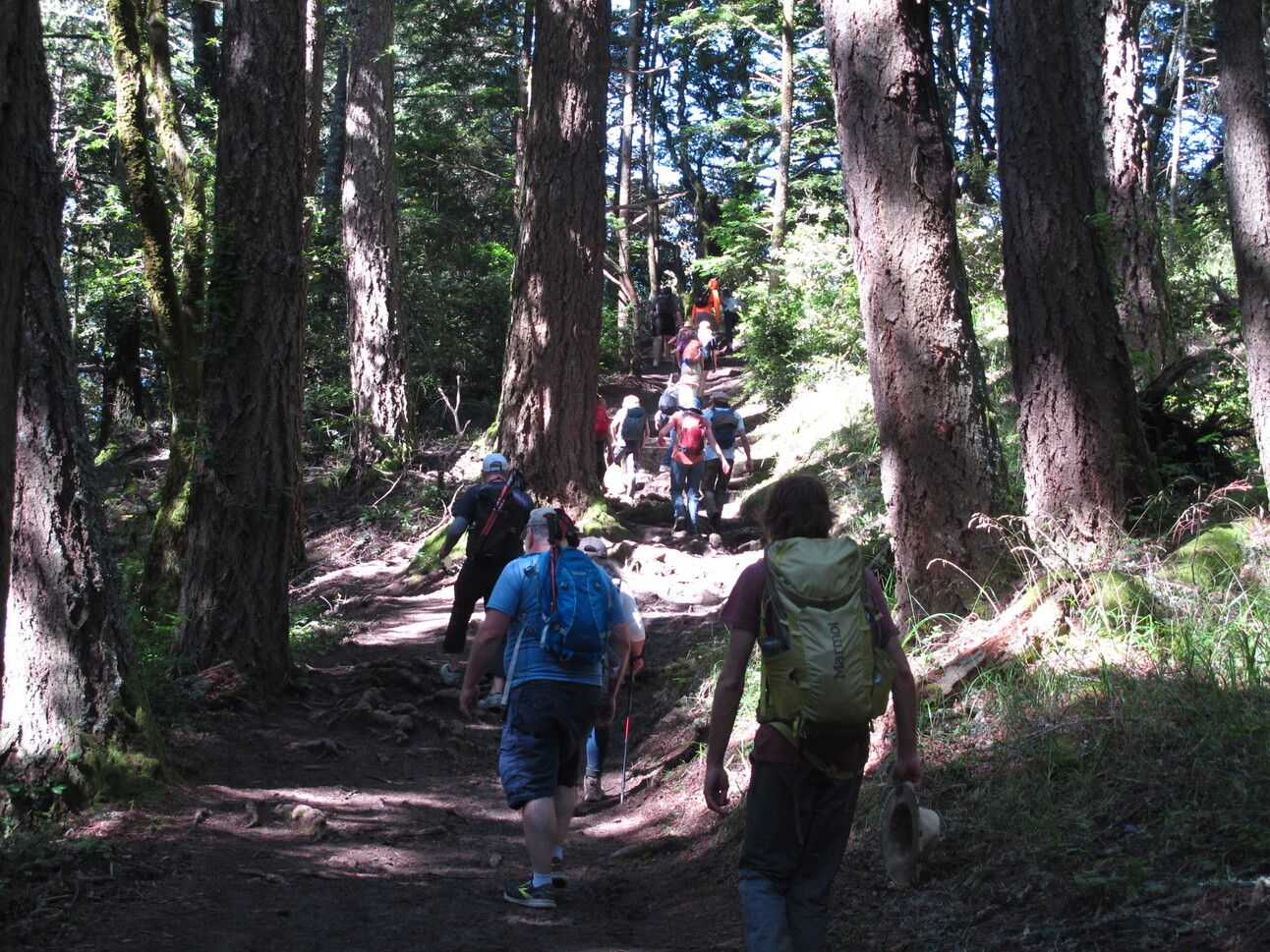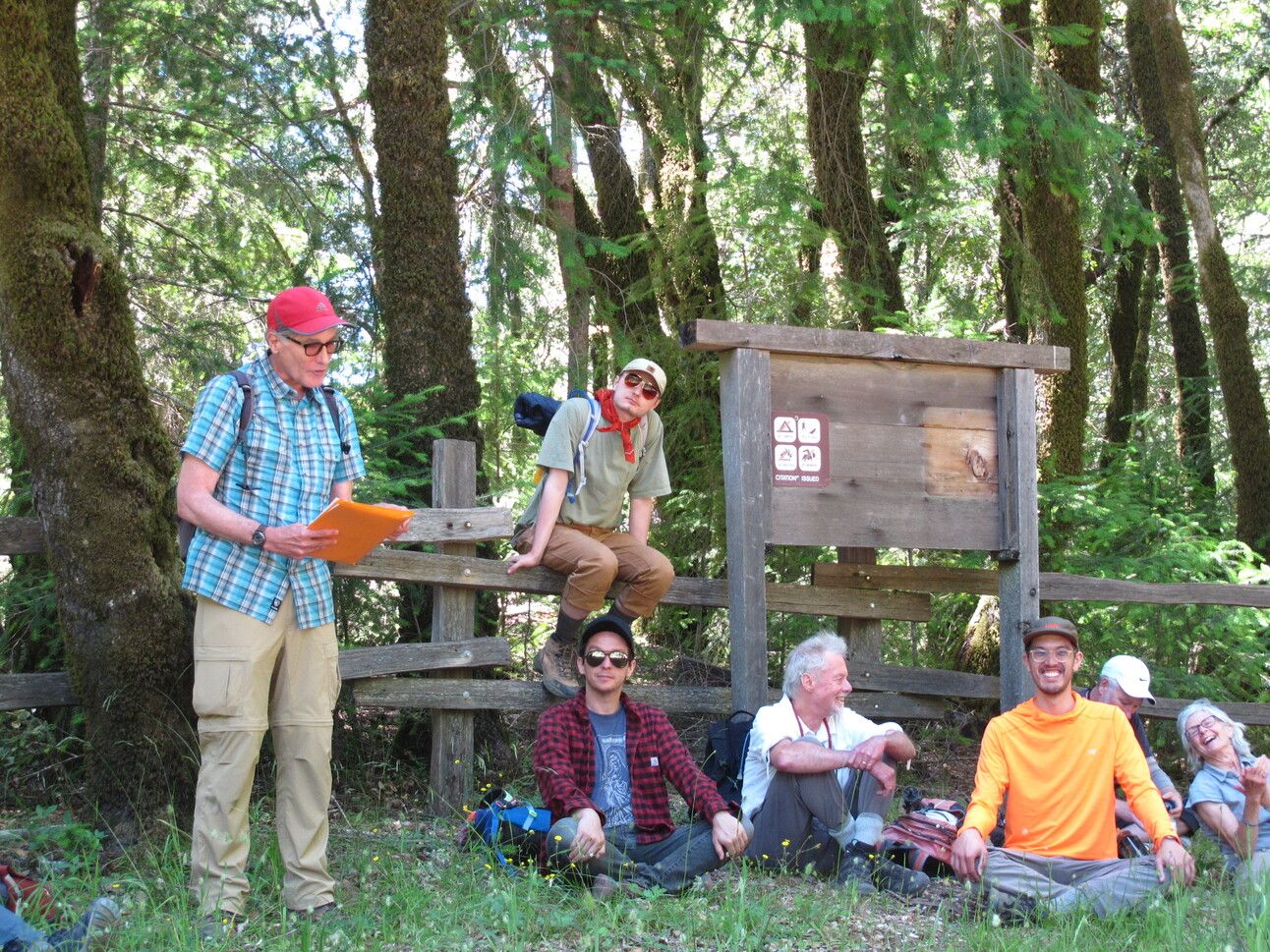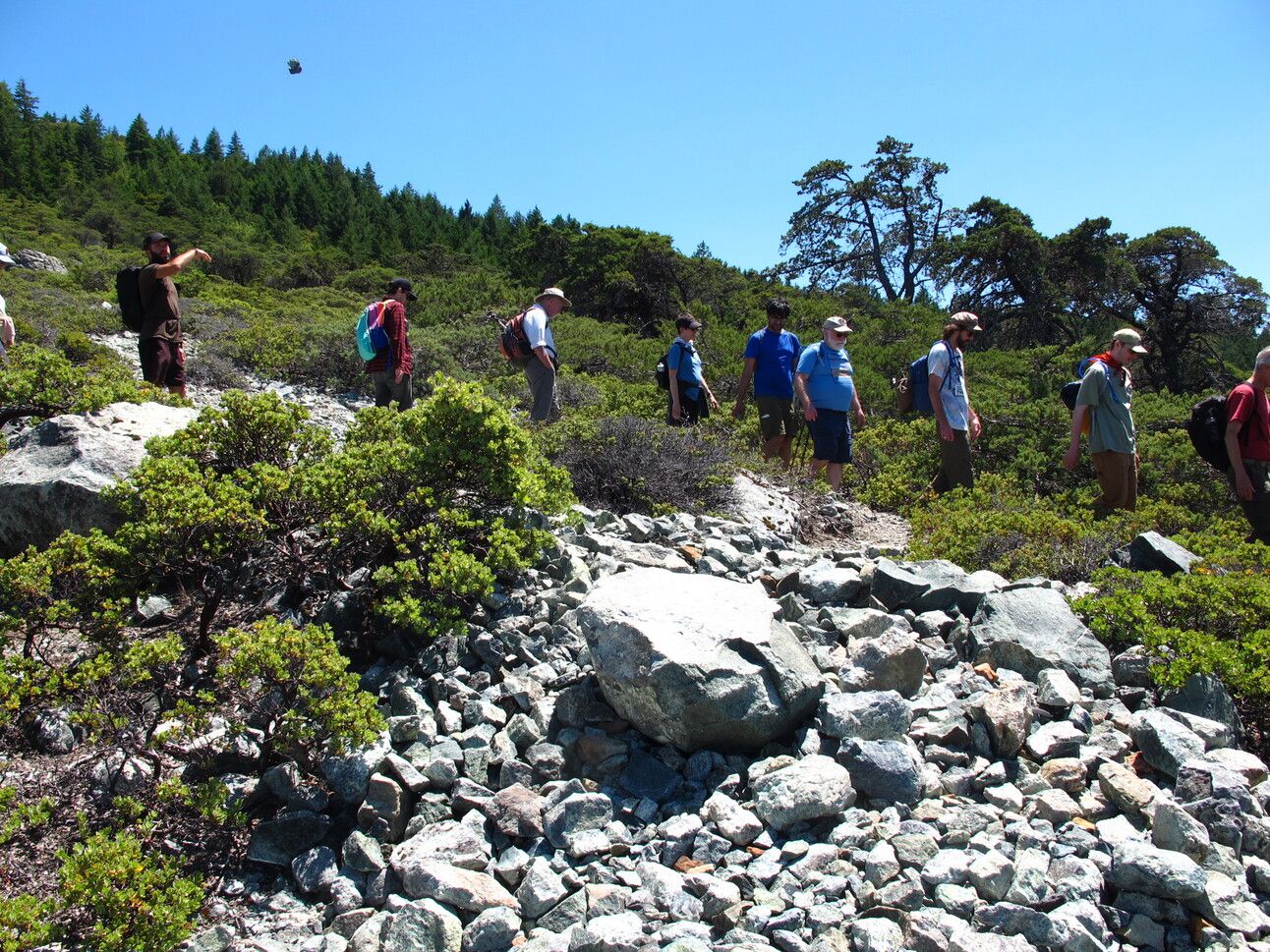By Katie Renz

View of the Bay and downtown SF from near the top of East Peak. Credit: Nicolas Smith
Amid searching for a new apartment and new job, I needed to get out of the city, the hustle, and my head, even if just for a day. What better way to give a gentle middle finger to San Francisco’s much ballyhooed “doom loop” than embarking on a more positive spiral: a communal circumambulation of Mt. Tam to celebrate the summer solstice?
This past June 18th, circumambulators were offered three simple instructions to keep in mind throughout the long day together, just ten syllables borrowed from a Gary Snyder poem, “For the Children”:
stay together
learn the flowers
go light

Circumambulating beneath the Doug firs. Credit: Katie Renz
This year’s gathering was hardly the first ritual walk circling the Bay Area’s signature peak. The initial vision came from Snyder. He began putting the pieces together for a backyard pilgrimage in 1956 while living in a house on the mountain’s flank that also served as a hang-out for the Beats. A student of Zen Buddhism, Snyder had heard of a ceremonial walking practice in Kyoto and around India’s holy Mt. Kailash.
More locally, he wanted to establish an intentional course—a clockwise journey from bottom to top to bottom again—to “open” the mountain, to create a place-based practice future generations could follow to pay their respects to nature, culture, and spirit.

The Eye of Sauron, bookended by bridges.
Snyder and fellow poets Philip Whalen and Allen Ginsberg completed the circuit on October 22, 1965. Less than a month after the Human Be-In in Golden Gate Park in January ’67, an invitation for a public circumambulation ran in a Haight-Ashbury newspaper. About 70 people attended, as documented in the book Opening the Mountain: “Lots of hair….Students, poets, painters, photographers, housewives, hippies, 2 school-age kids, Dharma bums, etc.”

New growth.
Since the fall of 1974, the circumambulation has happened on each solstice and equinox (or the closest Sunday). It was kept strong through the decades by two devoted guides, the late Matthew Davis and then the late Laura Pettibone; it’s now guided by Gifford Hartman, a San Francisco-based educator and labor historian.
Local Journalism for Working stiffs
We write for the poets, busboys, and bartenders. We cover workers, not ‘tech’, not the shiny ‘forbes 100 bullshit’. We write about the business on your corner and the beer in your hand. Join the Bay's best newsletter.
This summer solstice, the 29 people meeting on the plank bridge crossing Redwood Creek just west of the Muir Woods parking lot didn’t seem too different from that original group. This was the first and last of twelve stations along the route where we would stop to chant, read poetry, rest, and tell stories. Snyder, Ginsberg, and Whalen had designated these sites of notable beauty or power as places to pause and honor the mountain. They felt the act of chanting encourages the energy to continue on to the next station.

Lunchtime at Potrero Meadows.
With ravens croaking their own Corvid chant from the canopy, we tentatively attempted to recite the opening Heart Sutra in Japanese. After dual bellows from conch shells, we started the climb up the Dipsea Trail from this low point 150 feet above sea level.
Our second stop was 1.6 miles and 900 feet up, making me happy to save my breath by following the custom of keeping silence for the first third of the route, though Gifford reminded us of the ritual’s anarchist and playful ethos, describing this suggestion as “a practice, not a discipline.” I was impressed by the two participants going barefoot, recalling the long tradition of creative attire, or lack of it, from flowing skirts to the men from the Sexual Freedom League who walked the entire route naked.

Sharing stories in the shade of Bay Tree Glade, Station Five.
Some personal highlights from the eleven-hour-long pilgrimage:
-Station Two, with its lichen-draped coast live oak twisting from an equally lichened boulder, is named “Tree-out-of-Rock.” The last line from Mary Oliver’s essay, Upstream, emphasizes this practice is as much about presence as it is about place: “Attention is the beginning of devotion.”
-At Pantoll we stop for snacks, a pee break, and conversation. Repeat circumambulator Jason Reinier tells me the value of the ritual extends beyond any outcome, and that “the idea of community is more important than the process.”
-With a panoramic view of San Francisco, Mt. Diablo, and Richardson Bay, a participant dubs the Salesforce Tower “the Eye of Sauron.”
-Station Six, “Serpentine Power Point,” is an expanse of California’s turquoise-green state rock that a Chinese geomancer named Professor Lee once called “the spiritual driver’s seat of San Francisco.” Our jaunty call-and-response mantra to Krishna as Cowherd—Gopala Gopala Devake Nandana Gopala—is the first I can keep up with, pronounce, and get stuck in my head.
-Two miles away is Station Seven, “Serpentine Cairn,” a heap of more serpentine rocks surrounded by stunted Sargent’s cypress that lend this power point a High Sierra vibe. Traditionally the site of a Muslim chant, this year an Iranian hiker led us in the solidarity mantra, “Women! Life! Freedom!” both in English and Farsi: “Zan! Zendegi! Azadi!” We walk around the cairn three times, becoming a circle within the circle, and add our own shards of serpentine tossed on the pile.
-The group diverges just below the high point of East Peak: some choose the mellower ascent of the fire road while others climb a steep shortcut known as the “Manzanita Mangle,” an elfin forest of scratchy but compassionate shrubs offering their burgundy-colored branches as handholds.

Zan Zendegi Azadi at the Serpentine Cairn, Station Seven.
Finally, the descent. Pop an ibuprofen, bust out the knee-saving hiking poles, try to maintain footing on eroded fire roads, and fantasize about a cold pale ale.
We reach Station Twelve, back to Muir Woods near Redwood Creek, with almost three hours of daylight to spare. We’ve returned to where we began, changed and charged by the experience in between. We chant the Heart Sutra again, this time in English. The blowing of the conch shells makes me jump, so mantra’ed-out am I after these 17 miles.

Reading Gary Snyder’s “Smokey the Bear Sutra” at Mountain Home Parking Lot, Station Eleven. CRUSH THEIR BUTTS.
Feeling a rare sense of joyousness as I pack up to leave, it becomes obvious that part of the power of a circumambulation is in seeking the sacred wherever you are, free of cost or striving. No expensive psychotherapy, Prozac side effects, Kundalini yoga, ayahuasca shits, or carbon-guzzling flights to Nepal required.

A coast redwood that’s witnessed hundreds of circumambulators over the years. Credit: Nicolas Smith
So head to Tam, should it call you, or open your own mountain of choice, taking advantage of the 50+ hills shaping San Francisco. See how it feels to honor something special with a circular pilgrimage, be it as simple as walking a ring around a Monterey pine in McLaren Park, a scraggly rooftop garden, or a favorite bartender (ask, first). And if in doubt?
stay together
learn the flowers
go light
The post SF’s Backyard Pilgrimage: Walking a Circle Around Mt. Tam appeared first on Broke-Ass Stuart's Website.









